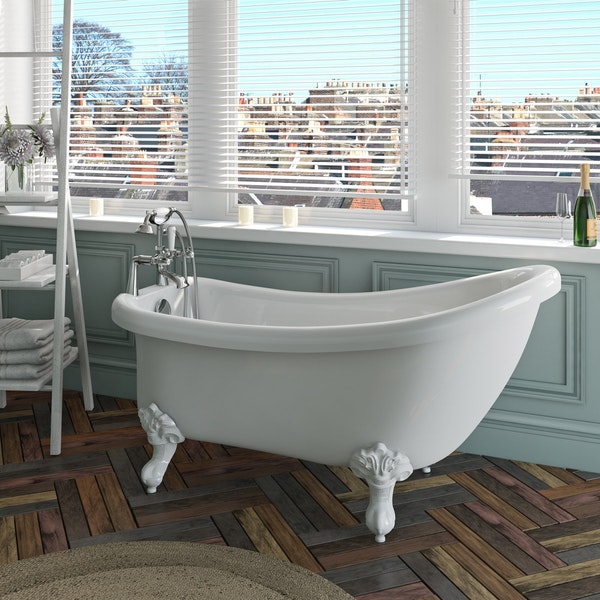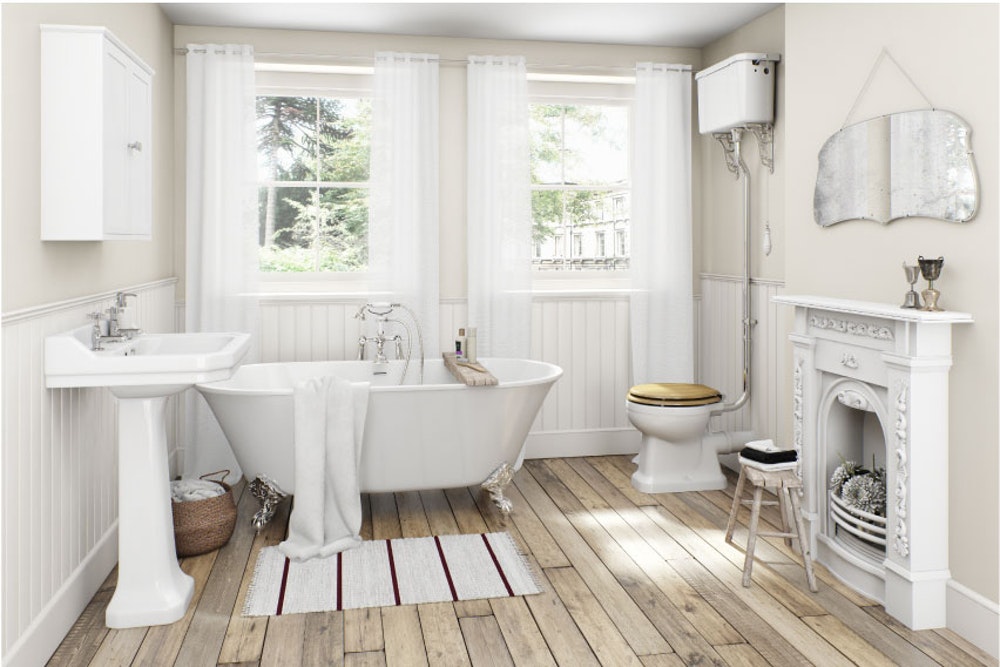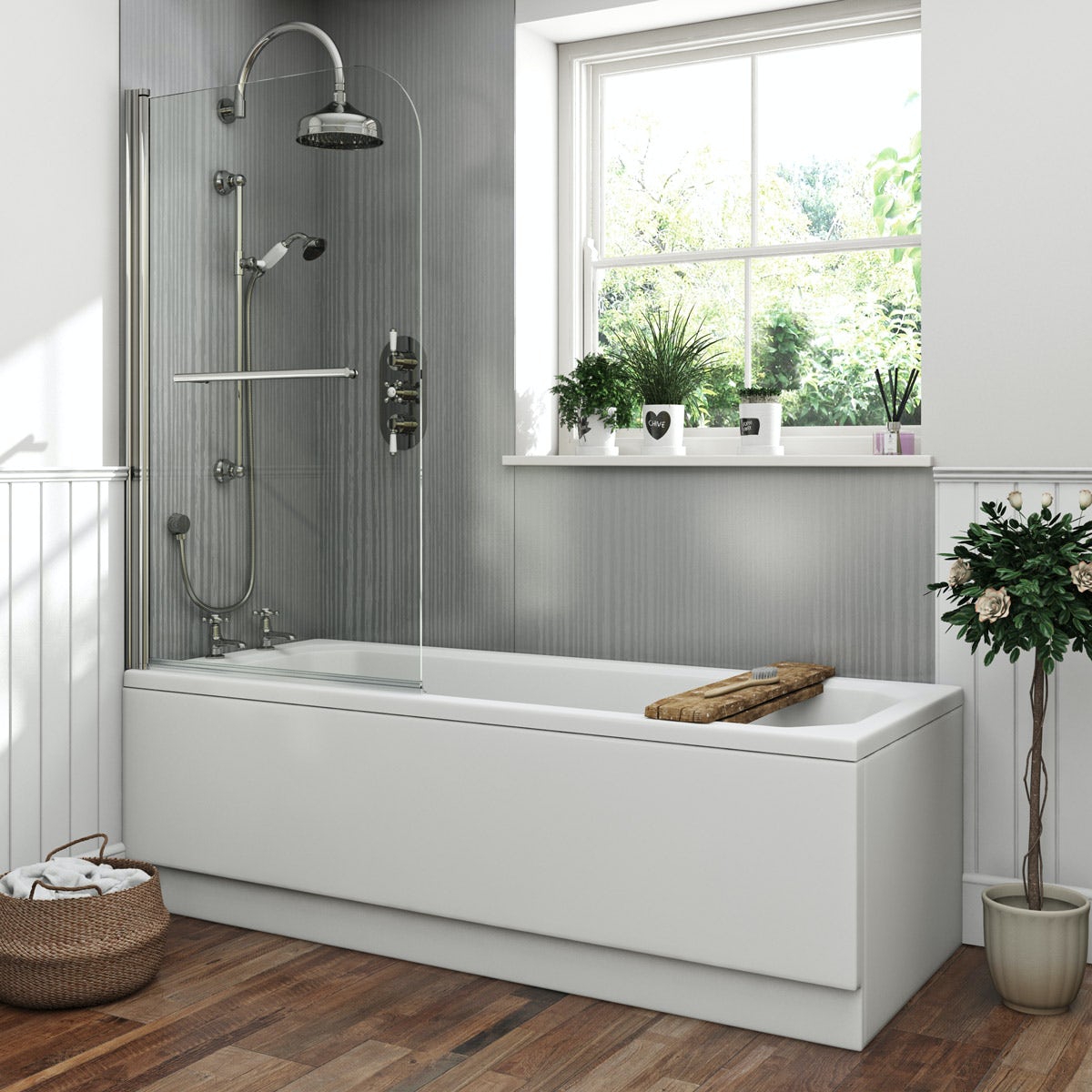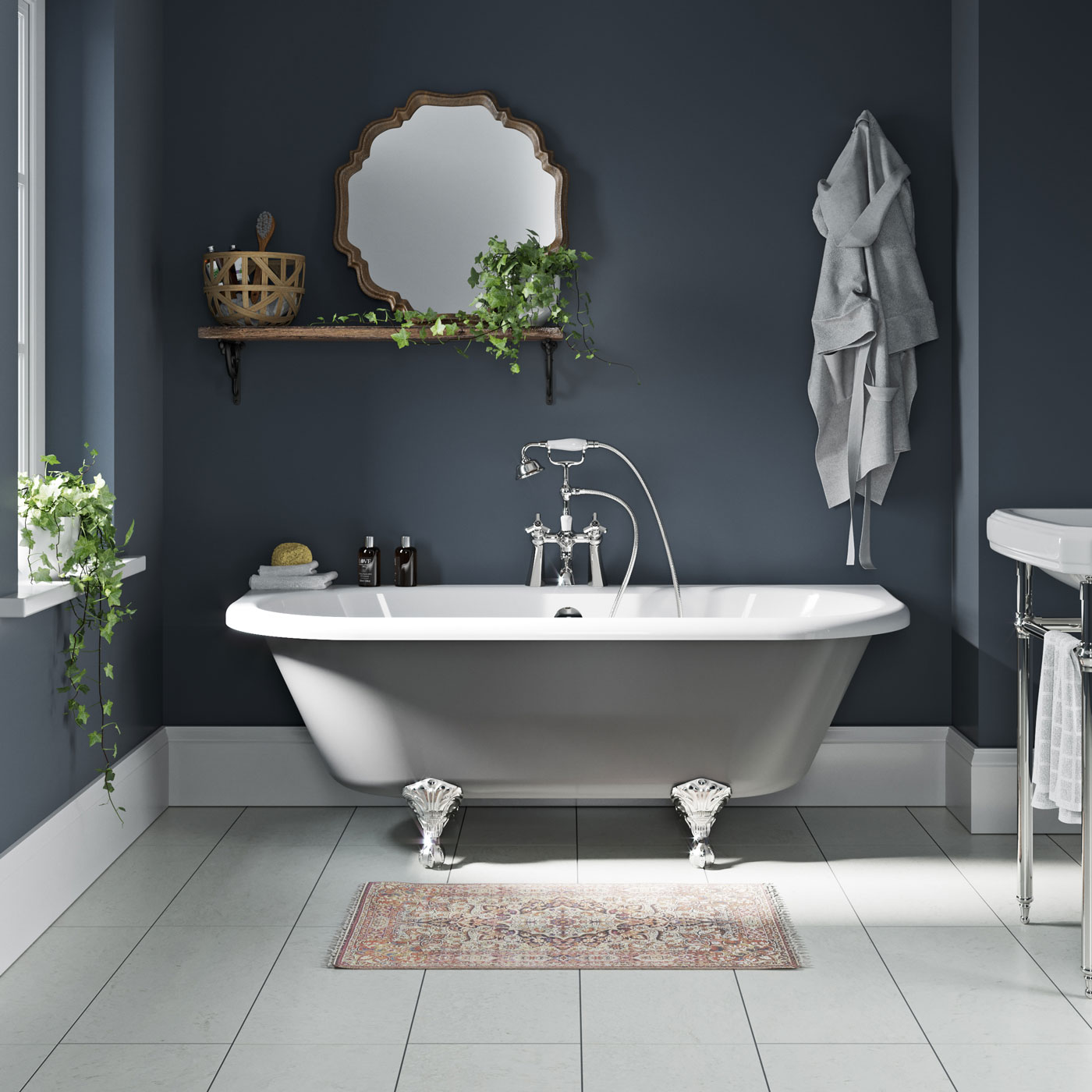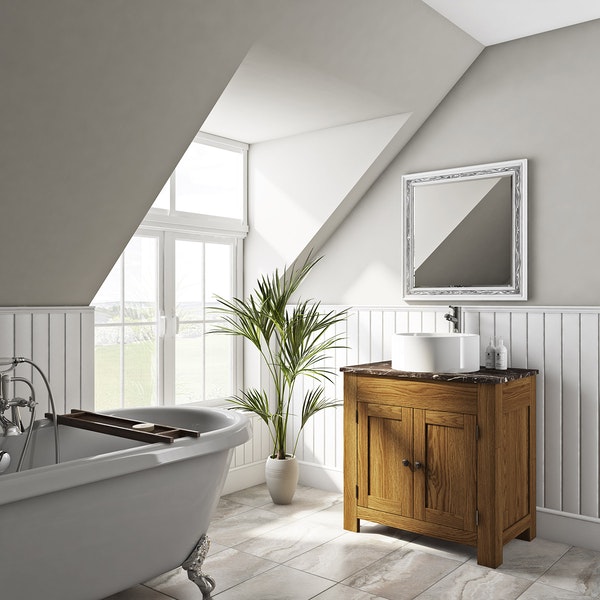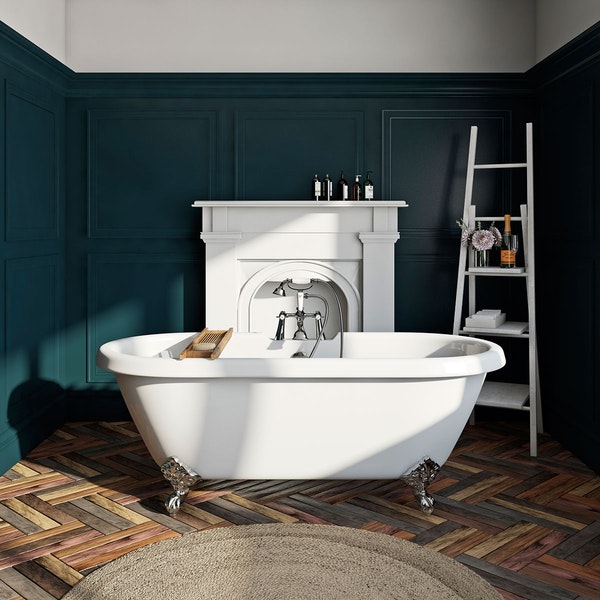When we talk about choosing the perfect bathtub for our needs, size is unquestionably one of the most important aspects to consider. Bathtub size is necessary for parents of young children, the elderly, and anyone with limited space, but the size of the bathtub can also have a huge impact on the design and ambiance of a bathroom. Modern, deep-soaking Japanese-style bath tubs can give a luxurious spa-like atmosphere, while classic claw-foot tubs can offer a vintage or romantic touch. In this blog post, we’ll jump into all the details you need to know when it comes to choosing the right sized bathtub for your bathroom and some tips to help you make the best decision. Let’s get started!
Quick Breakdown
The size of your bathroom and the shape of the space where you will be placing the tub are important factors to consider when choosing a bathtub. You’ll also need to factor in if you’d prefer a bath or shower and how many people will use the tub at a time.
Measure Your Space
When it comes to measuring the space you have available for your new bathtub, accuracy is essential – so use a tape measure to get precise measurements. Measure from wall-to-wall, wall-to-doorway, corner-to-corner, and any other applicable spaces. Pay attention to any objects you must work around like cabinets, shelves, or booms. Consider the material of the walls that the bathtub will be placed against – are they sturdy enough to support a heavy tub? Also note if your walls have any shifts in elevation – this may need to be accounted for when calculating size and depth requirements.
The harder decisions come when debating between several possible bathtub sizes that could fit into the same size space. If two sizes are nearly identical in total surface area and height, then you must decide which one offers better ergonomics and design elements. With only a small amount of difference in size between models, factoring in future replacement costs is key. Does it make more financial sense in the long run to purchase a slightly smaller model that might need to replaced sooner? Or should you invest in a slightly larger model now with extra room for movement and comfort but with higher upfront costs? Weigh all pros and cons carefully before making your selection.
Now that you’ve taken all measurements of your bathroom space, it’s time to calculate the ideal bathtub area size for your needs.
Calculate Your Bathtub Area Size
Calculating your bathtub area size is an essential step in choosing the perfect bathtub for your bathroom. Knowing the dimensions of your bathroom will help you choose the right size bathtub and decide which type of bathtub best fits your needs. To determine the correct size for a bathtub, it’s important to measure both the length and width of the area where you plan to install it. If you don’t have exact measurements, start by making a few measurements from adjacent walls and then do some simple math calculations to determine the total area of the space.
Once you know the approximate total space for your tub, you can then determine whether a standard-sized or custom-sized tub is best for your bathroom. Standard-sized tubs come in sizes from small to large and usually range from 36 inches wide by 60 inches long to 60 inches wide by 72 inches long. These tubs are relatively easier to install and may be more economical if they fit within the existing dimensions of your bathroom. On the other hand, if standard-sized tubs don’t fit, opting for a custom-sized bathtub may be necessary to make sure the area looks cohesive once complete. Custom tubs are created according to exact measurements, allowing homeowners to get exactly what they want out of their bathroom design. However, custom-sized tubs tend to cost more than standard-sized ones due to preparation of special materials and additional installation time.
In conclusion, calculating your bathtub area size is key in selecting the right size bathtub for your bathroom. With this in mind, let’s move on to the next step: choosing the right size bathtub for optimal comfort and aesthetic appeal in your bathroom.
Choose the Right Size Bathtub
When selecting the right size of bathtub for your bathroom, it’s important to consider the size and layout of the room, as well as your personal preferences. A larger tub may offer more comfort and pleasure when taking a soak, but space is always a consideration. On the other hand, a smaller tub may look good in a small bathroom, but can lack the same level of comfort.
To choose the correct size bathtub for your bathroom, you will need to measure your space and also determine what type of bathtub you prefer. When measuring the space available, be sure to factor in storage needs and any additional items you want in the bathroom such as a shower enclosure or bidet. Measuring for a new bathtub should include floor area and wall space restrictions. It’s also important to consider that some tubs require an alcove recess while others only require minimal wall clearance space.
When it comes to deciding on which size bathtub to purchase, there are advantages and disadvantages to both large and small tubs. A larger tub often provides more relaxation and luxury when taking a bath or shower, while a smaller tub can make use of limited space effectively. People with larger bathrooms may find that a bigger tub fits their needs better whereas someone with a smaller bathroom may prefer a more compact version such as a corner tub or drop-in style instead of full-size measurements.
Ultimately when it comes to size, finding balance between aesthetics and practicality is key. Consider how much time you spend in the tub and if you have other people over who play an important role in your decision making process.
Choosing the right size bathtub can be daunting but armed with this knowledge, it doesn’t have to be difficult. Now let’s move on to looking at the different types of bathtubs that are available so you can make an informed decision on which one best suits your needs.
Types of Bathtubs to Consider
When searching for the perfect bathtub for your bathroom, it is important to be aware of the types of bathtubs available on the market so you can make an informed decision. The main categories of bathtubs are alcove tubs, drop-in tubs, freestanding tubs, and soaker tubs.
Alcove Tubs: Enclosed on three sides by walls or paneling, alcove baths are available in a variety of shapes and sizes, including oval and rectangular. They are often equipped with integral aprons that cover two full sides of the bathtub. Alcove tubs provide good back support since they typically have a gentle slope along the length or width of the bath.
Drop-In Tubs: Drop-in bathtubs may require more construction than other types since they must be installed above floor level with a raised deck or platform. They sit in place against three walls, with their edges rising over the top of the decking that forms the fourth side. These baths often feature a skirted skirt, tiling, or other decorative trim around each side rather than one integral apron. As a result, maintenance is often required to keep them looking tight and clean.
Freestanding Tubs: Often considered traditional fixtures but now also popular in modern bathrooms, freestanding tubs come in a variety of shapes and styles from classic slipper-style designs to lazy spas with jets for added relaxation. Due to their size and shape, these baths can have wide, open bottoms without needing a support system as part of their frame.
Soaker Tubs: Intended only for basic soaking purposes, these baths often feature straight sides with gently sloping bottoms to allow bathers to sit low in or near the waterline comfortably. Most soaker models are installed flush against one wall but they can also be set away from all walls like freestanding variants if desired.
As you consider these different types of bathtubs it is important to remember that any style can come in a variety of different materials ranging from standard acrylic to natural stone depending on your needs and budget. With this consideration in mind it’s time to move onto the next part of selecting a new bathtub – understanding where your drain will be located before making your final decision.
Consider the Location of Your Drain
When choosing the perfect bathtub for your bathroom, one of the most important considerations is the location of your drain. The issue of installing a drain can be incredibly complicated and time consuming as, depending on certain factors, it may involve tearing through tiles or flooring to create an access point for the drain.
In some cases, simply reconfiguring an existing drain may be enough provided that you’re dealing with standard piping and accessibility. However, if more extensive remodelling is required, it is strongly advised to hire a qualified plumber who will be able to safely install your bathtub’s drain without causing any damage.
Alternatively, if you’re looking to install a new bath in an area where there are no pre-existing plumbing lines, purchasing a slipper clawfoot tub might be a good solution since they don’t require any type of internal drainage and waste disposal system. While this type of tub requires little installation work, they bear considerable weight and therefore must be secured with extreme care and precision to avoid any potential damage from occurring.
To sum up, consider the location of the drain carefully before deciding and invest in hiring a professional if necessary in order to ensure a secure installation with minimal disruption. Next let’s talk about standard tub sizes; because size does matter when it comes to finding the right fit for your bathroom!
Standard Tub Sizes
When it comes to selecting a bathtub for your bathroom, an important factor to consider is the size of the tub you need. Standard tub sizes vary according to style and will help determine which type of tub will fit best in your space. Knowing the standard tub sizes can help narrow down your choices and make for a much smoother design process.
One popular standard size for alcove bathtubs is a 60-inch model. This usually fits perfectly into an alcove (the space between two walls) and can work with a variety of wall materials. A slightly larger 66-inch alcove tub works well when there is more space available in the alcove area. These tubs are generally easier to enter and exit because they offer more interior width than a 60-inch tub.
For corner installations, corner bathtubs come in both standard sizes as well as custom sizes. Common standarized corner tub sizes include 36 inches by 36 inches, 48 inches by 48 inches and 60 inches by 60 inches square models. These measurements refer to the exterior and allow for maximum use of limited space in an area where two walls meet at a ninety-degree angle. Corner models that are designed under or on the edge of a window are typically custom fitted due to the variation of the room size and window placement.
Outside of standard sizes, pedestal tubs are also a popular option when it comes to bathrooms with limited space but still want to go big on design. For a luxurious look, these lift feet off the ground, making them appear like a freestanding accent piece in your bathroom retreat. While standard pedestal tubs can measure up to 72 inches long, you might need to consider a custom option if your bathroom does not have enough depth for this kind of bathtub installation.
Overall, carefully measuring your bathroom along with noting any existing fixtures will guide you in determining the right bathtub size for your needs. With careful research and choosing from among standard versus custom solutions, selecting the perfect bathtub just became simpler and easier!
Now that you understand more about standard tub sizes, let’s move onto looking at how will your tub fit – after all, it’s important that you get it right!
How Will Your Tub Fit?
When it comes to deciding how a bathtub will fit into your space, size definitely matters. Whether you have an existing bathroom or are remodeling, you’ll want to be sure that the tub you choose is the right size for the space. Measure carefully and consider what type of tub, configuration, and hardware best suit your needs before making your final purchase decision.
If you are installing a new tub in an existing space, the first step is to measure the dimensions—length, width and height—of the area where the bathtub will be located. Keep in mind, these measurements must include any protrusions like pipes or walls that may come into contact with the tub sides. This type of install requires only minimal work since there will likely already be plumbing, electrical wiring and tilework in place. But when updating an existing tub, you’ll need to make sure that your replacement model fits precisely into the allotted area.
On the other hand, if you are renovating a bathroom into which no previous tub was installed, then you’ll have more flexibility when it comes to sizing because you won’t have to worry about any obstructions. Before selecting and ordering your dream bathtub, keep in mind what types of materials—such as marble or tile—you plan on using to finish around your new feature and make sure they accommodate the overall dimensions of your tub selection without encroaching on any of its parts (e.g., handles and spouts). Also remember that when selecting a model with built-in accessories like armrests and shower caddies, ensure there is enough room for them within the frame of your tub selection regardless of how much extra space may be available beyond it.
No matter how much flexibility you have when selecting a new bathtub for your home redesign project, ultimate success lies in anticipating potential problems before they occur by factoring all constraining elements from day one. Now that you know how to choose a bathtub that best suits your needs and fits into existing spaces or areas being remodeled alike, let’s look ahead towards installation considerations in our next section: “Plan Ahead for Tub Installation.”
Plan Ahead for Tub Installation
Planning ahead of time for your tub installation is a crucial step in the process of selecting the perfect bathtub for your bathroom. There are two common approaches to installing a new bathtub: a professional install or a DIY install. Both have their benefits and drawbacks and choosing the right option largely depends on the layout of your bathroom and your own skillset.
Professional Install:
The benefits of having a professional install your new tub are numerous. Professionals will have the necessary tools, knowledge, and experience to perform the task safely and quickly, allowing you to enjoy the full benefit of your new tub sooner. Many professionals also offer warranties on their work, giving you added peace of mind that any future issues or repairs will be taken care of. The downside is that this will usually come at an additional cost which may be more than initially anticipated.
DIY Install:
If you are planning on doing it yourself, there are some important considerations to keep in mind. Firstly, make sure that you understand exactly what work needs to be done before starting on anything. Take measurements, assess any existing plumbing set-up, read up as much as possible about tub installation and prepare for any potential problems before getting started. Additionally, it’s important to factor in potential costs such as tools, fixtures or materials. While DIY installation may be very rewarding, it can also be quite time consuming and potentially risky so if you’re not confident in your skillset then it might be worth considering hiring a professional instead.
No matter which route you decide to take when installing your new bathtub, having a plan in place ahead of time can help ensure that everything goes smoothly and that the perfect bathtub for your bathroom is installed correctly with minimal disruption and stress.
Must-Know Points
Before selecting and installing a bathtub, it is important to understand how the process will be carried out. There are two main approaches: a professional install or a DIY install. Professional installation has many benefits such as warranties and fast service, but it often costs more than initially anticipated. DIY installation is cheaper, but will require one to take measurements, assess any existing plumbing set-up, read up about tub installation and prepare for any potential problems ahead of time. In order to ensure an efficient and successful experience, it is helpful to have a plan in place beforehand.
Commonly Asked Questions
What are the key considerations when selecting the right size bathtub?
When selecting the right size bathtub, there are several key considerations to think about. First, consider the size of your bathroom. A larger bathroom may accommodate a bigger tub while a smaller one may limit the size options available. Second, think about how you plan to use the tub. If you plan on taking relaxing soaks or hosting multiple people at once, then a larger size bathtub might be best for you. On the other hand, if space and convenience are priorities for you, then a smaller or mid-sized tub could be ideal for your needs.
Third, account for accessibility requirements. If someone in your household is elderly or has mobility issues, then it’s important to select a tub that makes it easy to get into and out of. Lastly, consider practicality as well as aesthetics when picking out the right size bathtub. While an aesthetically pleasing design is important, ensure that it is practical and meets your personal needs before making a purchase.
What are the different sizes of bathtubs available?
There are a variety of bathtub sizes available to suit any bathroom remodeling project. The most common sizes range from a standard-sized tub measuring 5 feet by 2.5 feet, to a small corner tub measuring 48 inches by 48 inches, to an extra-large soaking tub measuring 6 feet by 3.5 feet. The size that is best for your bathroom will depend on the size of the space and the budget you have available.
For a single person or couple, a standard-sized bathtub is a great choice as it provides plenty of room for bathing and showering. For larger families or those looking for added luxury, an extra-large soaking tub can be the perfect addition to create an oasis in their home. Those with limited floor space can opt for a corner-style bathtub as this provides ample space for one or two people while conserving valuable square footage in the bathroom.
What are the advantages and disadvantages of each type of bathtub size?
Small bathtubs (50-60 inches in length) are great for smaller bathrooms as they don’t take up a lot of space. However, these types of tubs will be too small for those who would like to enjoy a full body soak. Additionally, while they may be easier to install, they may not offer the same comfort level as larger tubs due to the shallow design.
Medium size tubs (60-70 inches in length) are great for those who want a full body soak, but still need to conserve some space. Many of these tubs offer a variety of bathing options, such as built-in jets and seating options. However, they may not have the deep soaking depth that larger models have and installation may be more complicated than with a smaller model.
Large bathtubs (over 70 inches in length) offer the most luxurious bathing experience since they provide plenty of room to stretch out and relax. However, since they are so large, they require extra room in the bathroom and may be much more difficult to install. Additionally, these larger tubs can often be quite expensive since they require advanced plumbing and additional materials.

